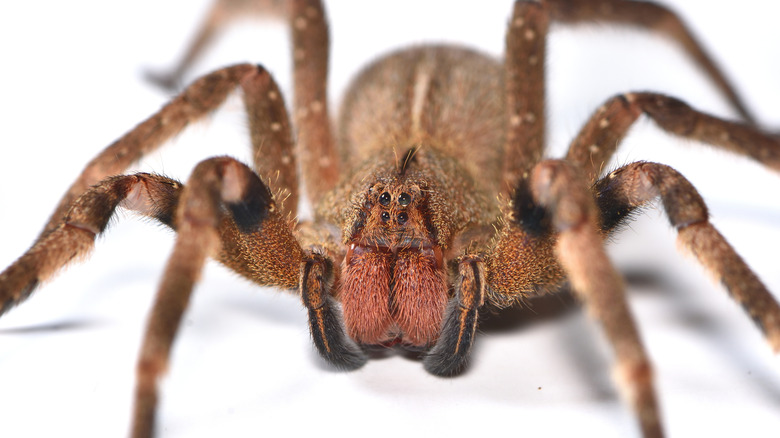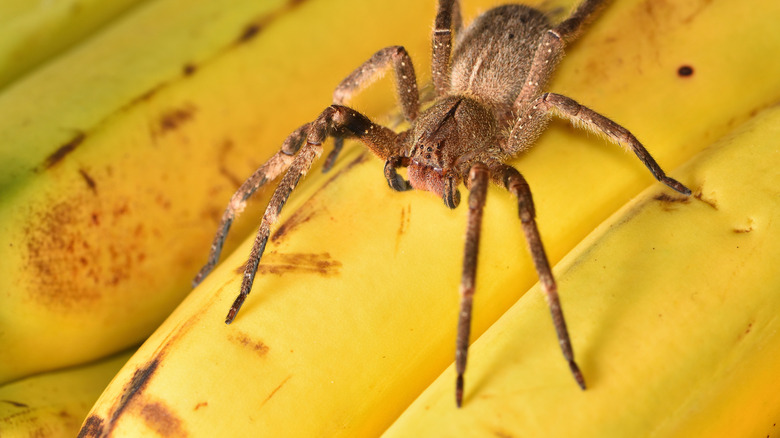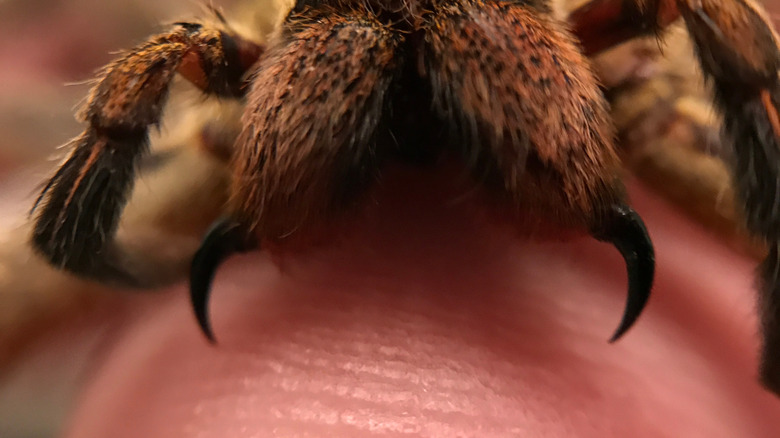Why The 'Banana Spider' Is Considered One Of The Deadliest
Out of the over 50,000 species of spiders identified by scientists, only a few are responsible for human deaths. That may come as a surprise, since virtually every spider species is venomous to some degree. However, the word "venomous" carries a strong connotation that can be misleading. Because spiders prey on tiny animals, such as insects, other spiders, and, at the largest end of the food spectrum, small vertebrates, their venom isn't potent enough to take down a creature as big as a human being — usually.
Only about 0.05% of all spider species possess venom considered "medically significant" to humans. Among the various types of dangerous spiders, those commonly known in North America include the black widow and the brown recluse. Curiously, the deadliest spider in the world also has a name in English-speaking countries, but not because it's a native. The Brazilian wandering spider is referred to as the "banana spider" due to its tendency to show up in shipments of bananas arriving from South America.
There are nine species of the Brazilian wandering spider within the genus Phoneutria. All nine are found in Brazil, though several have extended ranges that can reach as far north as Costa Rica and as far south as Argentina. Based on the toxicology of Phoneutria venom alone, Guinness World Records has recognized the Brazilian wandering spider as the most venomous spider. However, the venom of certain funnel-web spiders from Australia is also considered a contender for the title. Nonetheless, the uniquely toxic venom of the "banana spider," combined with its aggressive nature, make it unequivocally the deadliest spider to humans.
The Brazilian wandering spider doesn't set traps — it actively hunts
The unique hunting strategy of the Brazilian wandering spider explains why it's responsible for so many interactions with humans and also why the genus has evolved such potent venom. Most spiders employ intricate web designs to ensnare their prey. There are other hunting strategies, too, such as those of tarantulas, which dig burrows, and other species that create spider-silk tripwires. In all strategies, venom is used to immobilize prey once it has already been captured.
The Brazilian wandering spider, however, doesn't wait. The two-inch spider hunts by "wandering" the forest floor, so it's always on the move. All nine species of Brazilian wandering spider are nocturnal hunters. They may perch in strategic positions, and hide during the day (often among the leaves of banana plants), however, their main hunting strategy is to remain mobile.
It makes sense that the Brazilian wandering spider should have developed such a fast-acting and toxic venom. With no webbed traps to capture its prey, Phoneutria spiders must depend on quickly envenomating their victims before they can escape or fight back. Their nomadic lifestyle also demands active defense. Some spiders and insects can escape a threat by jumping away in a flash, and others can retreat to the safety of their webs or burrows. The Brazilian wandering spider has no such safety measures. Instead, it makes a stand. The spider forms an aggressive posture by raising its front legs in the air, and it will lunge forward to envenomate anything close and threatening enough. Thus, the Brazilian wandering spider's venom must be powerful enough to both immobilize prey and its own predators. For humans, such aggression seems hot-headed. For the banana spider, it's simple survival.
The effects of banana spider venom are fast and severe
If you're ever bitten by a Brazilian wandering spider, don't panic, because panicking makes it worse. A rise in heart rate increases the speed at which the venom travels to other parts of the body and, ultimately, to the brain. And while the nearly immediate pain from the bite is extreme, it's actually the least dangerous part. Phoneutria venom quickly attacks receptors within the neuromuscular system, effectively destroying the pathways between the brain and the muscular system.
The effects include sweating, sporadic changes in blood pressure, an irregular heart rate, abdominal pain, convulsions, feelings of nausea, and shock. All this can occur within 30 minutes of receiving the bite, so fast access to medical treatment is critical. Due to the fast action of the venom's toxic effects, most hospitals in areas with a high incidence of Brazilian wandering spider bites carry antivenom.
Despite how serious all of that is, though, there aren't actually that many cases in which a bite from the Brazilian wandering spider proved fatal. According to some sources, only 10 people have ever been confirmed to have died from Brazilian wandering spider bites out of 7,000 recorded cases. Alternatively, a 2000 study from Brazil reported that between 1984 and 1996, only 0.5% of patients bitten by the spider experienced "severe" envenomation. Another study claimed that only 15 deaths had ever been confirmed in Brazil since record-keeping started in 1903. The statistics vary depending on the source, but it's clear that the death rate of the world's deadliest spider is considerably lower than that of most of the world's deadliest animals. So while spiders may trigger an instinctual fear response in human beings, even the most dangerous species are actually not worth worrying about.


